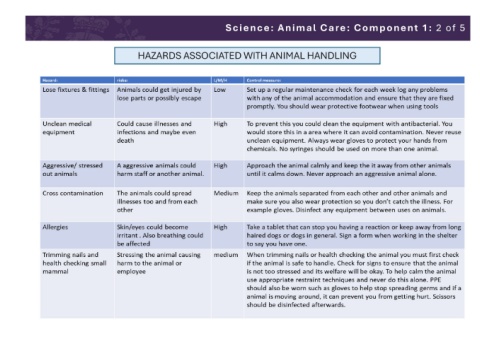Page 97 - Year 10 Knowledge Organiser
P. 97
Science: Animal Care: Component 1: 1 of 5 Science: Animal Care: Component 1: 2 of 5
Normal HAZARDS ASSOCIATED WITH ANIMAL HANDLING
Behaviour Explanation
Depending on species animals have different feeding behaviours. This will also depend on how the animal has evolved and if the animals lives in the wild
Feeding Behaviours or not. Larger animals need to consume a larger amount of food. Animals fall into different categories depending on what they eat. For example,
herbivores, carnivores or omnivores. Herbivores eat plants, carnivores eat animals and omnivores eat both plants and animals.
Some animals are diurnal, nocturnal or crepuscular. This refers to their sleep cycles. The majority of mammal species are nocturnal, which means active
Sleep & wake cycles during the night. However, many are diurnal which means active during the day. The final sleep cycle refers to crepuscular animals which means animals
are active during twilight.
Communication behaviours can help animals find mates, establish dominance, defend territory, coordinate group behaviour, and care for young. Some
Methods of
communication species rely more on one form of communication over another. Many animals will do this through vocalisation/sounds and scenting. Scenting is when
animals release pheromones (airborne chemicals) to send messages to others.
Animals may show courtship behaviours such as grooming each other, playing and wrestling, chasing each other or bumping and hip pushing each other.
They will also sniff and lick each other, and a female may even position herself in front of her partner to tell him she's ready. Whereas a mating display
Sexual behaviour
is a set of display behaviours in which an animal, usually a male, attempts to attract a mate; the mate exercises choice, so sexual selection acts on the
display.
There are two ways animals groom themselves, these are called Autogrooming or Allogrooming. Allogrooming strengthens social bonds and helps to
provide all members of a group with a scent characteristic of the group, by means of which group members may identify one another. Allogrooming
benefits each individual and develops a bond between the animals, it serves to facilitate and mediate social interactions within primate groups. This
Grooming
allows for successful group living, which entails large fitness benefits for group members. Autogrooming is any grooming behaviour performed by an
animal on its own body. This behaviour typically includes licking, chewing, clawing, and rubbing. This comfort behaviour is typically performed for
hygienic purposes
Play & Social Many species seek out social bonding with other species which often involves play behaviours. Play can act as a form of communication between
Interaction companions in which the participants mutually understand that the interaction is playful and pleasurable.
Movement & Levels This means the proportion of time that animals spend active. The type of movement will depend on the animal for example: movements include
of Activity walking, running, jumping, crawling, climbing, swimming, flying, galloping, slithering, and so on

